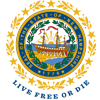NH State Wildlife Action Plan
A Blueprint For Conserving New Hampshire’s Wildlife and Land
How does NH Fish and Game and its many conservation partners around the state prioritize actions for wildlife and land management? How do you, as a member of your community and a landowner, become part of the movement to conserve and maintain New Hampshire’s natural environment? The entire state has a plan that guides conservation actions, so that you, your community, university researchers, biologists, land trusts, and other organizations are all working towards NH’s most important conservation goals. This is the New Hampshire State Wildlife Action Plan. This Plan first became available in 2005, and has now been completely updated and approved by the US Fish and Wildlife Service.
The 2015 Wildlife Action Plan is a blueprint for conserving Species of Greatest Conservation Need (SGCN) and their habitats in New Hampshire. New Hampshire's Plan identifies 169 SGCN, which represent a broad array of wildlife, and it focuses on the 27 habitats that support these species, such as lowland spruce-fir forest, salt marsh, shrublands, warm water lakes and ponds, vernal pools, and many others. Each SGCN and habitat has an individual profile that includes information about the population, threats, and actions needed to conserve these features in New Hampshire. The many actions listed in the Plan include activities like on-the-ground habitat work and research, land conservation, habitat management, collaborating with many conservation partners, and providing public education. It will take active participation by all Granite staters to implement the actions in the State Wildlife Action Plan, and the Taking Action for Wildlife program is the best place to start.
How are SGCN different from Threatened and Endangered Species?
“Threatened and Endangered species” are those species that are legally protected under the New Hampshire Endangered Species Conservation Act (1979) and / or the Federal Endangered Species Act (ESA) (1973). The US Fish and Wildlife Service and NOAA’s National Marine Fisheries Service are responsible for administering the ESA, and New Hampshire Fish and Game is responsible for administering the New Hampshire Endangered Species Conservation Act. Plants are under the authority of the Department of Natural and Cultural Resources – Natural Heritage Bureau. Species included on the SGCN list are not regulated or granted specific protections for being listed as SGCN. The New Hampshire SGCN selection process states that all state and federally listed Threatened and Endangered species that regularly occur in New Hampshire are also included as SGCN. The proposed 2025 SGCN list includes 51 species that are listed as Threatened or Endangered.
How can I get involved?
Check back on this page and our NHFG social media pages for notices about public participation opportunities.
What are State Wildlife Grants?
Established in 2000, State Wildlife Grants (SWG) fund state programs that are working to conserve Species of Greatest Conservation Need and their habitats, and address the threats identified in the State Wildlife Action Plan. This work has the goal of delisting or preventing species from being added to state or federal Endangered Species Act listings. SWG-funded projects depend on collaboration between state wildlife agencies, conservation partners, the public, and private sectors to implement the conservation actions listed in the SWAP.
What is a State Wildlife Action Plan?
State Wildlife Action Plans (SWAPs) are an assessment of wildlife and habitat health in each state, created every 10 years by all US states and territories. In addition to assessing the current condition of a state’s natural environment, SWAPs identify the species and habitats that are at risk, the threats they are facing, and provide a blueprint for how to conserve these species and habitats. To be eligible for federal State Wildlife Grants, Congress requires state wildlife agencies to submit a revised SWAP every 10 years.
Upcoming Surveys and Volunteer Participation Opportunities
The revision of the New Hampshire State Wildlife Action Plan is a group effort—we need your input to develop the most relevant and achievable conservation actions. You can be a key contributor to this influential and important state-wide plan, and help us develop the most strategic conservation actions for New Hampshire’s wildlife and land. Key stakeholders include groups such as landowners, natural resource professionals, environmental and wildlife researchers, land trust organizations, environmental education groups, conservation commissions, state agencies, municipalities, outdoorsmen and women, New Hampshire businesses, citizen scientists, and other volunteers, and the general public.
Check back here for updates on public participation opportunities.



